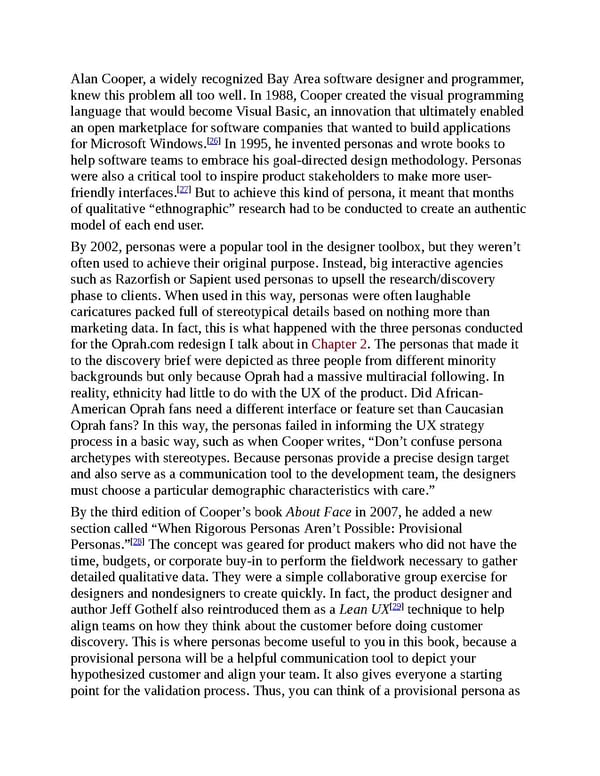Alan Cooper, a widely recognized Bay Area software designer and programmer, knew this problem all too well. In 1988, Cooper created the visual programming language that would become Visual Basic, an innovation that ultimately enabled an open marketplace for software companies that wanted to build applications [26] for Microsoft Windows. In 1995, he invented personas and wrote books to help software teams to embrace his goal-directed design methodology. Personas were also a critical tool to inspire product stakeholders to make more user- [27] friendly interfaces. But to achieve this kind of persona, it meant that months of qualitative “ethnographic” research had to be conducted to create an authentic model of each end user. By 2002, personas were a popular tool in the designer toolbox, but they weren’t often used to achieve their original purpose. Instead, big interactive agencies such as Razorfish or Sapient used personas to upsell the research/discovery phase to clients. When used in this way, personas were often laughable caricatures packed full of stereotypical details based on nothing more than marketing data. In fact, this is what happened with the three personas conducted for the Oprah.com redesign I talk about in Chapter 2. The personas that made it to the discovery brief were depicted as three people from different minority backgrounds but only because Oprah had a massive multiracial following. In reality, ethnicity had little to do with the UX of the product. Did African- American Oprah fans need a different interface or feature set than Caucasian Oprah fans? In this way, the personas failed in informing the UX strategy process in a basic way, such as when Cooper writes, “Don’t confuse persona archetypes with stereotypes. Because personas provide a precise design target and also serve as a communication tool to the development team, the designers must choose a particular demographic characteristics with care.” By the third edition of Cooper’s book About Face in 2007, he added a new section called “When Rigorous Personas Aren’t Possible: Provisional [28] Personas.” The concept was geared for product makers who did not have the time, budgets, or corporate buy-in to perform the fieldwork necessary to gather detailed qualitative data. They were a simple collaborative group exercise for designers and nondesigners to create quickly. In fact, the product designer and [29] author Jeff Gothelf also reintroduced them as a Lean UX technique to help align teams on how they think about the customer before doing customer discovery. This is where personas become useful to you in this book, because a provisional persona will be a helpful communication tool to depict your hypothesized customer and align your team. It also gives everyone a starting point for the validation process. Thus, you can think of a provisional persona as
 UX Strategy: How to Devise Innovative Digital Products that People Want Page 62 Page 64
UX Strategy: How to Devise Innovative Digital Products that People Want Page 62 Page 64